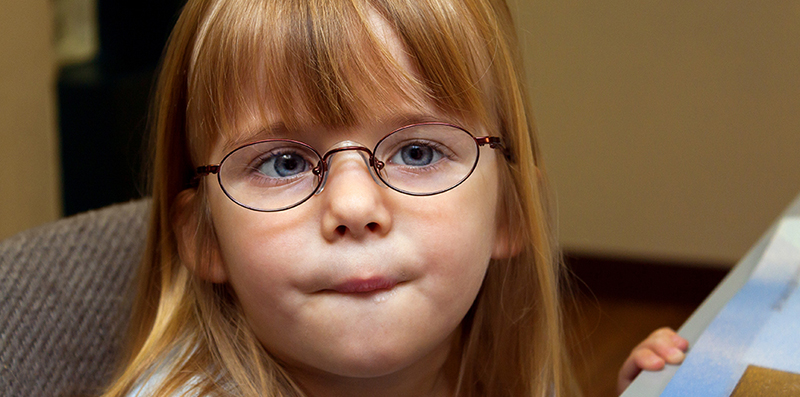Lazy Eye: 12 Things You Didn’t Know

1) Lazy eye is not a turned, crossed, or wandering eye.
People, even general medical professionals, easily confuse this. The medical term for lazy eye is amblyopia. Amblyopia is the lack of development of clear vision (acuity) in one (or even sometimes both) eyes for reasons other than an eye health problem that cannot be improved with glasses alone. Lazy eye (amblyopia) is often confused with strabismus which is a turned, crossed, or wandering eye. You can read more about the difference between strabismus and amblyopia here.
2) Strabismus (crossed eyes, eye turn, or squint) is the leading cause of lazy eye (amblyopia).
There are three main types of amblyopia, all of which result from suppression of vision in one or both eyes. Suppressing is the term for when the brain ignores visual input from an eye. The difference between the types of amblyopia is in the root cause of the suppression. In strabismic amblyopia, to avoid double vision caused by poorly aligned eyes, the brain ignores the visual input from the misaligned eye, leading to amblyopia in that eye. People who have strabismic amblyopia are more likely to have a noticeable eye turn than people who have the other types of amblyopia. You can read more about strabismic amblyopia here.
3) Someone with lazy eye may show no eye turn at all
Sometimes, a lazy eye is caused by unequal acuity in the two eyes, despite perfect eye alignment. For example, one eye may have significant nearsightedness or farsightedness, while the other eye does not. Or one eye may have significant astigmatism and the other eye does not. In such cases, the brain relies on the eye that has less uncorrected refractive error and "tunes out" the blurred vision from the other eye, causing amblyopia in that eye from disuse. This type of lazy eye is called refractive amblyopia (or anisometropic amblyopia). These patients will not show an eye turn, their eye alignment is just fine. You can read more about refractive amblyopia here.
In other cases, lazy eye is caused by something that obstructs light entering and being focused on the light-sensitive cells of the retina. This can happen even in a baby's eye, such as a baby with a congenital cataract. This is called deprivational amblyopia and these patients also do not often exhibit an eye turn.
4) Diagnosis of lazy eye is often missed at the pediatrician and during school vision screenings.
Unfortunately, despite all good intentions, school vision screenings can give a false sense of security when it comes to vision problems beyond general distance acuity. These screenings are designed to alert parents and teachers to the possibility of a visual problem, but should not take the place of a visit to an eye care practitioner. It may seem hard to believe, but lazy eye is just one of the vision problems commonly missed during school screenings and during early childhood wellness checks at the pediatrician’s office. In school, pediatricians are provided a very limited amount of training and education regarding eyes and vision. They perform very basic screenings, not comprehensive assessments. Lazy eye can only be diagnosed by an eye care professional. Because early intervention improves treatment outcomes, it is important to have your child seen within the first year of life. The InfantSEE® program from the American Optometric Association provides a cost-free comprehensive evaluation during the first year of life with optometrists trained to evaluate pediatric and infant patients.
5) Lazy eye can be treated
We regularly hear from people who have been told they simply have to live with their lazy eye and that nothing can be done to treat it. As with many conditions, diseases, and treatments in the medical world, research has furthered our knowledge and understanding of amblyopia and strabismus over time with an extensive amount of progress happening over the last decade or two. Much of this is based on new understanding of the pathophysiology that has come in part thanks to advancements in new brain-imaging methods such as functional MRI. Neuroplasticity is the term used to describe the ability of the nervous system to change and adapt. It was once thought that the neuroplasticity of the visual system was lost after adolescence, but recent clinical trials have led to a massive shift in thinking about adult neuroplasticity.
For hundreds of years, the primary treatment for amblyopia has consisted of patching or penalizing the fellow preferred eye, thus “forcing” the brain to use the weaker amblyopic eye. Today, the scientific community (optometrists, ophthalmologists, vision scientists, neuroscientists, et al) is dedicating research to more effective (and less invasive) treatment options based on the concepts of perceptual learning and dichoptic viewing while utilizing new technology such as virtual reality. These treatment options are proving successful in patients of all ages whereas previously patching and penalization treatments were only used in children.
6) Lazy eye can only develop in childhood
A “critical period” is a timeframe of aggressive neural growth and development. Each sensory system has multiple critical periods of development that a child progresses through. Each of these stages build a foundation for the next, and allow the child to develop new, important skills used for the rest of their life. Early observations found that amblyopia simply does not develop after the age of 6-8 years old.
Because there is a critical period for the development of vision, and the observation that amblyopia occurs if there is a problem during this period of time, a foregone conclusion was (erroneously) made that there is a critical period for its treatment as well. Advancements in research have now proven this to be outdated thinking, however; it persists even among eye care professionals today.
Amblyopia is, aside from refractive error, the most common cause of visual loss in children. When diagnosed and treated early, the visual losses may be completely reversed. Because the development of vision and visual skills occur early in life, it is important that children receive a comprehensive vision assessment during the first year of life (and regularly thereafter) by an eye care professional, not just screenings.
7) Lazy eye can be treated at any age
We now know that there is not a “critical period” in which amblyopia must be treated. The “recovery period” for these conditions continues through life—albeit easier to treat if diagnosed and treated earlier. It is now known and supported widely by research from vision science, optometry, ophthalmology, and neuroscience, that patients of any age can successfully be treated for amblyopia (including strabismic amblyopia). Again, despite these advancements, it is still best if these conditions are diagnosed and treated early on. You can read more about lazy eye in adults here.
Recent research (Ziak et al) has shown visual acuity as well as stereo acuity can improve at statistically-significant levels in amblyopic patients outside of the “critical period” using virtual reality vision therapy technology. Another recent study (Ho et al, 2019) also showed improved visual acuity and stereo acuity in amblyopic and strabismic patients aged 3-69 using virtual reality vision therapy technology who were previously unsuccessful in traditional patching or occlusion therapy.
8) Lazy eye can be treated through non-invasive treatment options
Treatment of amblyopia can include vision therapy, eye patching, eye drops, refractive surgery, or a combination of those options. Often, the first line of treatment for patients with amblyopia is prescription eyeglasses or contact lenses.
It is a well known fact (and reported in scientific studies on the subject) that eye patching and eye drop penalization methods of treatment come with significant complications especially with compliance. Vision therapy is a non-invasive option that provides a safe alternative to surgery or use of pharmaceutical agents. Vision therapy may include the use of virtual reality technology in treatment of lazy eye. You can read more about vision therapy here.
9) Lazy eye has historically been treated with medical eye patches which does not provide binocular treatment with sustained results
For many years, the assumption was that amblyopic patients are anatomically monocular and lacked any functional binocularity. However, recent findings have provided strong evidence for intact binocular processes in adult amblyopes that may have appeared to have been lost but were, in reality, suppressed. (See Hess et al 2014)
Research has shown that applying monocular treatment methods (such as patching) does not reduce suppression, does not strengthen fusion, and does not help re-establish binocularity in amblyopic patients. In fact, stronger suppression may be associated with poorer response to patching therapy in children. Additionally, studies have shown that despite improvements in acuity in the amblyopic eye following patching treatment, there is a significant chance of regression and binocular outcomes remain poor. (See Hess et al 2015)
10) People with lazy eye may seem uncoordinated, have trouble reading, experience double vision, etc.
Patients with lazy eye experience varying degrees of binocular vision problems such as a lack of stereopsis or depth perception. This can impact people in an incredible number of ways—they may appear clumsy, bump into things, have trouble riding a bike or parking a car, or feel uncomfortable in crowded spaces. They likely experience trouble reading or doing computer work—they may get headaches, experience words moving or doubling on the page, etc. They are likely, at some distance, to experience double vision...possibly constant but perhaps only sometimes. They may or may not even be aware of this. These kinds of symptoms can cause a patient great anxiety.
Often times, successful treatment of amblyopia (using patching techniques) is measured only by improvements in visual acuity-- the measure of someone’s ability to see clearly at a distance of 20 feet. As most patients with amblyopia will tell you, their visual acuity in the amblyopic eye is only part of the larger problem. Studies show that amblyopia results in poorer outcomes on tests of skills required for proficiency in everyday tasks and which relate to childhood academic performance.
Children often do not know that what they are experiencing isn’t normal, so they don’t report problems. This is again a reason why childhood visits to a vision care professional is so important. You may not even realize your child has a problem and it may lead to unnecessary struggle for them in school and beyond.
11) Patients who have overcome lazy eye describe it as “life changing”
There are many success stories from patients who have overcome both amblyopia and/or strabismus at all ages from around the world. These are inspiring accounts that provide an insight into just how significant the impact of these visual conditions can be. It goes far beyond the oversimplified perception that it’s just the cosmetic appearance of an eye turn that people have to learn to live with. People have dropped out of school, suffered job instability, turned away from career goals, hid in bathrooms to avoid classes, become suicidal, and more. We invite you to take a look through some of the patient success stories here as well as the books Jillian’s Story: How Vision Therapy Changed My Daughter’s Life and Fixing My Gaze for informative and inspirational testimonials.
12) You can find lazy eye treatment near you today!
If you, or someone you know, could benefit from finding help for lazy eye please use our doctor locator page and find an optometrist near you today! There are 19.8 million people with a treatable eye condition living within 20 miles of a Vivid Vision provider! Find yours today!
References
Levi DM, Knill DC, Bavelier D. 2015 Stereopsis and Amblyopia: a mini-review. Vision Res. 114 17–30.
Hess RF, Thompson B. 2015 Amblyopia and the binocular approach to its therapy. Vision Res. 114 4–16.
You may also be interested in these blog posts:
- What is lazy eye?
- What causes lazy eye?
- How to fix a lazy eye
- Vision Therapy Success Stories: Jillian
- Vision Therapy Success Stories: Clayton
